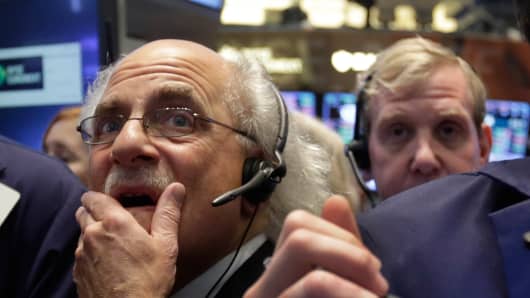Legitimate or not? NYSE lets stand trades in utilities American Electric Power (AEP) and NextEra Energy (NEE), but removes many trades from the tape.
The NYSE has let stand all trades in AEP and NEE. But in an additional decision that is raising eyebrows, it has decided to remove all trades from the tape that were roughly three to four percent below the opening price.
To recap: AEP opened at $48.18, just below the prior close, but quickly traded down on several exchanges to as low as $22.28.
NEE opened at $78.62, also just below the prior close, but quickly traded down to as low as $30.37.
NYSE officials quickly met to review whether any of those trades should be busted under the clearly erroneous trade rule, which allows trades to be busted if there is a mistake in the order. The rule is very clear: "A Clearly Erroneous Execution ("CEE") is an execution with an obvious error in any term, such as price, number of shares or other unit of trading, or identification of the security."
Was there an error made? The NYSE determined that the trades were based on market orders, limit orders, and stops that drove pricing down. In other words, legitimate orders.
The trades stand. Even the ones for AEP at $22.28 and NEE at $30.37.
OK, fair enough. They were legitimate orders, and the trades stand. Here's something that bugs me: the NYSE also said that all trades in AEP at or below $46.03 between 09:30:00 a.m. and 09:31:00 a.m. and all trades in NEE at or below $76.19 between 09:30:00 a.m. and 09:31:00 a.m. will be marked with an Aberrant Report Indicator.
What's that? Let the NYSE explain: "The NYSE notes that executions at these prices are still valid trades, but they will be excluded from the high and low data disseminated by the Consolidated Tape Association."
Huh? You mean the trades are still valid but the worst ones will never appear on the tape? That's exactly what it means.
Why? I am going to speculate: imagine being AEP. You're a dull utility. Investors buy your stock for yield and stability. Suddenly the whole world knows you had a trade at $22 and change, when your stocks was $48. It might make some think you're too volatile to own. Screaming executives.
The NYSE is now caught between a rock and a hard place. They have a stupid circuit breaker rule that does not allow circuit breakers to be used at the open (see below) that was forced on them and all the exchanges by the SEC, so it's not really their fault. But they have to mollify a customer--in this case, AEP and NEE. What to do?
Let the trades stand, but declare that the worst ones are "aberrant." No one sees them.
Sorry, I understand the dilemma, but this doesn't smell entirely right. Is it a legitimate trade or not? If it is, it shouldn't be hidden.
The companies are not happy. Moray Dewhurst, Vice Chairman and Chief Financial Officer, NextEra Energy, Inc., sent in the following statement to CNBC: "We are continuing to try to understand exactly what happened in the first few minutes of trading in our stock this morning. This is naturally a concern for all our shareholders and potential shareholders. This type of market behavior is not what we would expect from a well-functioning and well-regulated exchange."
Move on: how did this happen in the first place? There are two problems:
First, there is no circuit breaker protection for individual stocks between 9:30-9:45 a.m. ET and 3:30-4:00 p.m. ET. In other words, right after the open and right before the close.
During the rest of the day, the new circuit breakers (known as Limit Up, Limit Down) put trading halts on stocks that drop more than five percent in the prior five minutes.
Circuit breakers with full protection for the entire day (9:30-4:00) comes into effect on August fifth.
August fifth? That is no consolation. There is a major rebalancing at the close next week, and traders are nervous that could cause problems.
Don't blame the NYSE nor the NASDAQ: this was an SEC ruling. ALL the exchanges objected to not having circuit breakers in effect at the open or the close, but they were overruled by the SEC. Why? Not clear, but the SEC probably felt that they were unsure how well the new circuit breakers (which came into effect a few months ago) would work in the real world and wanted to avoid having them during the two most volatile times of the day.
That was wrong thinking: the circuit breakers have worked well. If they were in effect at the open--or the old NYSE circuit breakers were in effect--the problems with AEP and NEE would not have happened.
Second, books are thin. The opens are notoriously thin; there is very little stock to buy or sell on any of the order books.
Why did it happen with these two stocks? It's not clear, but it's likely the mix of market orders on top of unusually thin books. Remember: unless traders put a stop order in, a market order can quickly deteriorate.
This happened last week in Anadarko Petroleum (APC), when three large sell orders hit the tape in the last minute, causing APC to go from $90 to some trades that were executed at a penny. The NYSE then stepped in under the clearly erroneous trade rule and canceled all trades below $85.76, which was several percent below the last trade. So those trades were deemed a mistake.










